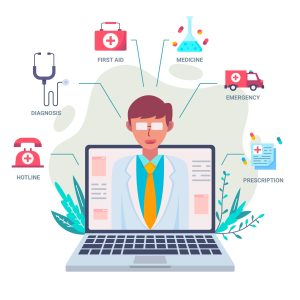
What Is Telemedicine Software?
Telemedicine software enables healthcare providers to deliver remote care through digital platforms. It connects patients and doctors via secure communication tools, enhancing access to medical services.
The Rise of Telehealth and Its Benefits
Telehealth has gained immense popularity, offering convenience, cost-efficiency, and improved patient outcomes. It breaks geographical barriers and ensures timely healthcare access.
Key Features of Telemedicine Software
Secure Video Conferencing
Facilitates real-time, encrypted communication between patients and doctors. Advanced encryption methods ensure consultations remain private and comply with healthcare regulations like HIPAA.
Appointment Scheduling
Streamlines the booking process with automated scheduling, reminders, and patient-provider synchronization. This reduces no-shows and optimizes provider time.
Electronic Health Records (EHR) Integration
Provides seamless access to patient records, ensuring accurate diagnoses and continuity of care. Integration with existing EHR systems allows for real-time updates and reduces administrative burdens.
Prescription Management
Enables doctors to issue and manage prescriptions digitally, improving patient convenience and ensuring compliance with local laws. Features like e-prescriptions and refill notifications enhance medication adherence.
Why Invest in Telemedicine Software Development?
Telemedicine software offers significant benefits for healthcare providers and patients. It improves patient engagement, expands service reach, and optimizes operational efficiency.
Benefits for Healthcare Providers and Patients
- Increased Accessibility: Patients in remote or underserved areas gain access to quality care without traveling.
- Enhanced Patient Satisfaction: Convenient access to healthcare fosters trust and loyalty.
- Reduced Overhead Costs: Minimized in-person visits lower infrastructure and operational expenses.
- Improved Workflow Efficiency: Automated systems save time for healthcare providers, enabling them to focus on patient care.
Steps to Develop Telemedicine Software
1. Research and Planning
Identifying Your Target Audience
Understand the needs of your target users, including patients, doctors, and clinics. This ensures the software is tailored to their specific requirements.
Understanding Regulatory Compliance
Ensure adherence to healthcare regulations such as HIPAA, GDPR, and other regional data protection laws to safeguard sensitive patient data.
2. Defining Core Features
Determine the must-have features based on user needs and industry standards. Incorporate scalability to accommodate future growth.
3. Choosing the Right Technology Stack
Select reliable and scalable technologies such as cloud computing, AI, and mobile-friendly frameworks to ensure seamless functionality across devices.
4. UI/UX Design for Seamless User Experience
Design intuitive interfaces that cater to both patients and healthcare providers. Use user-centered design principles to enhance accessibility and usability.
5. Development and Integration
Build the software using agile methodologies to ensure flexibility and rapid deployment. Integrate necessary tools, such as payment gateways, EHR systems, and analytics dashboards.
6. Testing and Quality Assurance
Conduct thorough testing to identify and fix bugs, ensuring reliability, security, and compliance. Perform usability testing to gather user feedback for improvement.
7. Deployment and Maintenance
Launch the software with a well-defined rollout plan. Provide ongoing support for updates, feature enhancements, and security patches to ensure optimal performance.
Challenges in Telemedicine Software Development
Data Security and HIPAA Compliance
Protect sensitive patient information with robust security measures, including encryption, secure authentication, and regular audits.
Scalability and Performance
Ensure the software can handle a growing number of users without performance issues. Optimize server infrastructure and implement load balancing to manage high traffic.
User Adoption and Training
Develop easy-to-use interfaces and provide comprehensive training for healthcare staff to maximize adoption.
Welcome to the Future of Healthcare with Telehealth Software
Welcome to a world where healthcare meets technology, where the power of communication is at the forefront of medical advancements. That’s right – we’re talking about telehealth software!
Telehealth software can come in many forms, from mobile apps to web-based platforms, and it allows for seamless communication between doctors and patients regardless of location.
Telemedicine technology specifics may vary across different healthcare environments such as:
-
 Telehealth for Primary Care
Telehealth for Primary Care Telehealth for Rural Areas
Telehealth for Rural Areas Telehealth for Physical Therapy
Telehealth for Physical Therapy Telehealth for Nursing Care
Telehealth for Nursing Care Telehealth for Neurology
Telehealth for Neurology Telehealth for Stroke Care
Telehealth for Stroke Care Telehealth for Pediatrics
Telehealth for Pediatrics Telehealth for Acute care
Telehealth for Acute care

In this blog post, we’ll be exploring the process of developing telehealth software and how it’s revolutionizing the healthcare industry.
Typically, it takes around 4 to 8 months to develop a telehealth application, involving several phases such as defining engineering specifications, project management, creating user experience and interface designs, developing the minimum viable product, and finally launching it.
Now, let’s dive into the process of developing telehealth software.
With our extensive expertise in creating Telemedicine Software, we provide a straightforward approach to developing a telemedicine application

Organizing Work through Effective Planning
It all starts with an idea and when a project is initiated, planning becomes crucial for better organization.
This planning encompasses:
![]() Outlining business requirements and defining the prerequisites for telehealth software
Outlining business requirements and defining the prerequisites for telehealth software
![]() Prioritizing and determining essential features of telemedicine software
Prioritizing and determining essential features of telemedicine software
![]() Gathering pertinent regulatory compliance requirements.
Gathering pertinent regulatory compliance requirements.
Forming a Team of Competent Experts
Whatever the idea may be, the first step is to gather a team of skilled developers, designers, and healthcare professionals who are passionate about making healthcare more accessible and convenient.
![]() Developers are responsible for writing code and creating the technical infrastructure that underlies the software.
Developers are responsible for writing code and creating the technical infrastructure that underlies the software.
![]() Designers create a user-friendly interface for patients and healthcare providers.
Designers create a user-friendly interface for patients and healthcare providers.
![]() Healthcare professionals ensure that doctor software features meet patient and provider requirements.
Healthcare professionals ensure that doctor software features meet patient and provider requirements.
Software Designing
Once the team is assembled, it’s time to start brainstorming and designing the software. This is where creativity comes into play.
![]() Creating unique features that differentiate the software from competitors.
Creating unique features that differentiate the software from competitors.
![]() Ensuring the telehealth app is user-friendly, secure, and compliant with regulations.
Ensuring the telehealth app is user-friendly, secure, and compliant with regulations.
![]() Developing a flexible design to meet diverse patient and provider needs.
Developing a flexible design to meet diverse patient and provider needs.
Testing and Debugging
Once the design phase is complete, the development team begins coding the telehealth application. This process involves writing the software code and creating the application’s technical architecture.
![]() Coding needs attention to detail to avoid errors and bugs.
Coding needs attention to detail to avoid errors and bugs.
![]() Thorough testing on various devices and platforms is necessary for proper software functioning.
Thorough testing on various devices and platforms is necessary for proper software functioning.
![]() User feedback is solicited during the testing phase to ensure that the application meets the needs and expectations of its users.
User feedback is solicited during the testing phase to ensure that the application meets the needs and expectations of its users.
Ready to Launch
Once the software is ready to launch, the team markets it to healthcare providers and patients.
![]() The team creates a website, social media accounts, and other marketing materials.
The team creates a website, social media accounts, and other marketing materials.
![]() These materials showcase the software’s features and benefits.
These materials showcase the software’s features and benefits.
![]() It should be easy for patients to download and use the software.
It should be easy for patients to download and use the software.
Valuable User Feedback
Finally, it’s important to continually update and improve the software based on feedback from users.
![]() Continuously gathering user feedback through direct feedback, analytics, and market research.
Continuously gathering user feedback through direct feedback, analytics, and market research.
![]() Prioritizing updates and new features based on user feedback to enhance the user experience.
Prioritizing updates and new features based on user feedback to enhance the user experience.
![]() Staying up-to-date with industry developments and regulatory changes for compliance and to taking advantage of emerging trends and technologies.
Staying up-to-date with industry developments and regulatory changes for compliance and to taking advantage of emerging trends and technologies.
Conclusion:
The process of creating telehealth software is intricate and multidimensional, requiring a group of qualified experts, an innovative perspective, and a strong desire to advance healthcare.
By transforming the way healthcare is provided and making it more comfortable for patients worldwide, telehealth software is revolutionizing the healthcare industry.
The deployment of Doccure Software within a few hours can minimize the effort and time required to build a Telehealth platform from scratch.
I hope these processes for developing telehealth software have been helpful for your project.
If you’re looking to create a telemedicine application or a telehealth video app, please don’t hesitate to reach out to us at ([email protected]) or call us at +91 99425 76886.
